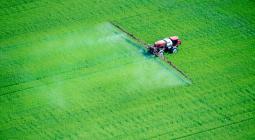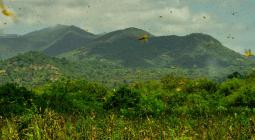Agricultural Poisons Tell a Tale of Two Californias
The Golden Rule doesn’t apply in the Golden State when it comes to protecting Latino and Indigenous farmworker communities from toxic pesticides.
Esperanza was washing off the dirt and sweat from another grueling day in the strawberry fields when she felt a bump on her right breast. It reminded the 44-year-old mother of eight of the milk clumps that formed after she’d weaned her youngest. Except it didn’t go away.
Esperanza, who is undocumented and asked not to use her last name to protect her identity, knew she should seek medical care after hearing PSAs on Spanish-language TV, she said through a translator.
She comes from an Indigenous community in southern Mexico and speaks Mixteco, like a growing number of California farmworkers, and picked up Spanish by watching telenovelas. The local community clinic in Watsonville, a major agricultural hub 90 miles south of San Francisco, couldn’t take new patients and referred her to the county health clinic.
She waited months for a mammogram appointment. When her results were ready, the clinic asked her to come in. Her heart sank. It must be bad if they couldn’t share the results over the phone, she thought.
Esperanza, a slight woman with her dark hair pulled back, looked pained as she recalled the shock of hearing the doctor tell her she had breast cancer.
She told the medical staff she worked in farm fields, but no one informed her that dozens of agricultural poisons increase the risk of cancer or that strawberry growers use copious quantities of particularly toxic, drift-prone pesticides on the soil before planting.
These fumigants are also used on other row crops and orchards, but strawberry growers apply them in the greatest quantities. One of their favorite fumigants—1,3-dichloropropene, also known as 1,3-D or Telone—causes tumors in multiple organs and glands in rodents, including mammary glands, studies show. California listed 1,3-D as a carcinogen in 1989, yet it remains the state’s third highest-volume pesticide.
And in Monterey County, the top-grossing strawberry growing region where Esperanza lives and works, farmers applied more and more 1,3-D even as statewide use declined. Between 2018 and 2022, applications of 1,3-D fell by more than 20 percent statewide, but rose by more than 80 percent in Monterey, according to an analysis by Inside Climate News.
The ICN analysis also suggests that the burden of this pollution falls disproportionately on immigrants with limited English proficiency—people who make up a large proportion of the agricultural workforce.
In the three Census tracts with the most intensive applications of 1,3-D from 2018 to 2022—all in strawberry-growing areas of Ventura and Monterey counties—there were more than twice as many people born in Mexico and other parts of Central America and with limited English skills than in the state as a whole, Inside Climate News found. These tracts also had around twice as many children aged 17 or younger, who are particularly vulnerable to toxic exposures.
Growers often apply 1,3-D in combination with another toxic fumigant called chloropicrin, which was originally deployed as a chemical weapon during World War I. Scientists can’t say whether it causes cancer because it’s so toxic it disables or kills test animals, compromising study results. Applications of this former military choking agent increased by almost 20 percent statewide from 2018 to 2022, with the same vulnerable groups being disproportionately exposed. Health experts worry that 1,3-D and chloropicrin may interact to do more harm to people exposed to both.
Immigrants and agricultural workers exposed to the chemicals come from underserved populations with multiple stressors that increase their susceptibility to toxic exposures, said environmental epidemiologist Paul English, an expert on tracking community health hazards and disparities.
“Lack of access to health care, poverty, poor housing, poor working conditions, all these things make them more vulnerable,” said English, who recently retired from the nonprofit Public Health Institute.
Volatile gases like 1,3-D and chloropicrin pose greater risks for young children, who inhale proportionally higher doses for their body weight than adults and can’t clear poisons as efficiently, research shows.
To gauge children’s potential exposures, Inside Climate News estimated quantities of 1,3-D and chloropicrin applied from 2018 to 2022, the most recent year of data available, within buffer zones extending two distances from the boundaries of school grounds: the quarter mile distance regulated by the state and a mile-wide buffer zone public health experts say is necessary to protect children, teachers and other workers at school sites.
The California Department of Pesticide Regulation, or DPR, prohibits applications of fumigants like 1,3-D within a quarter mile of a campus within 36 hours prior to the start of a school day. But 1,3-D can hang in the air for days and travel for miles on breezes. So health experts have urged pesticide regulators to require a 1-mile safety zone around schools 24 hours a day, seven days a week.
The Inside Climate News estimates are based on an analysis of fumigant applications at the level of “sections” in the Public Land Survey System, which typically measure about one square mile in area, and assumed the chemicals were used evenly across active cropland within each section.
It’s not possible to calculate exactly where the pesticides are applied given the limitations of the available data. But English, who co-led a groundbreaking 2014 study of pesticide use near schools while he was with the California Department of Public Health, reviewed the methods and said the results are reasonable estimates.
The analysis indicated that more than 1,000 schools had 1,3-D applied within a mile of their grounds, almost 800 had chloropicrin applied within a mile and nearly 700 had both fumigants applied within this distance between 2018 and 2022. Looking at the quarter-mile buffer zones, the analysis suggested more than 400 schools had applications of 1,3-D, nearly 300 had applications of chloropicrin and more than 230 had both fumigants used within a quarter of a mile.
Cover photo: Migrant workers pick strawberries during harvest on a farm south of San Francisco. Credit: Visions of America/Joe Sohm/Universal Images Group via Getty Images




